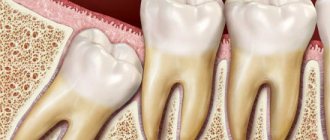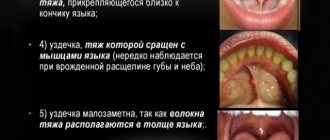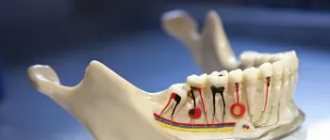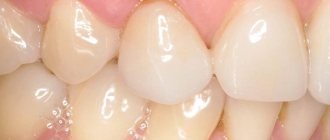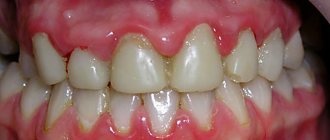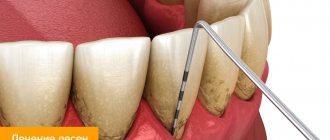Inflammatory processes in the gums indicate the presence of gingivitis or periodontitis. Gingivitis affects only the soft gum tissue. If the infection is not treated, the bacteria attack the connective tissue - periodontium. In advanced cases, both pathologies can lead to the need for surgical treatment: gingivectomy or gingivotomy.
The operations allow curettage of periodontal pockets, removal of abscess and excess tissue. The procedures differ in their methodology and indications.
How to get rid of a gum pocket
To get rid of the gum pocket, a surgical operation is performed - gingivectomy. It is possible with moderate severity of periodontitis, when cleaning the periodontal pocket from tartar, plaque and food debris, as well as medications no longer help. This can be explained by the fact that the gums, after removing stone and food debris, cannot immediately fit tightly to the body of the tooth. A person continues to consume food, and it again ends up in the gum pocket, rots and causes re-inflammation. To prevent this from happening, the edge of the gum must be trimmed a little, removing the gum pocket.
Get a gingivectomy at Dr. Granov's clinic!
Our dentists will carry out the necessary manipulations to get rid of the gum pocket, preventing more serious diseases!
Leave your phone number. The clinic administrator will call you back.
By leaving a request on the site, you consent to the processing of personal data
Make an appointment
Initial consultation with a dentist
400 rubles
Gingivectomy operation
The method of excision of the gingival wall of a periodontal pocket was first described in 1757 by the court dentist of the French kings Louis XV and Louis XVI, Etienne Bourdet. However, it entered the everyday practice of maxillofacial surgery only at the end of the 19th - beginning of the 20th centuries and received the name “gingivectomy” that is already familiar to us.
There are several types of gingivectomy: simple, partial (or “sparing”), radical.
A type of gingivectomy also includes gingivotomy, which differs in the depth and location of the incisions on the gum.
When is gingivectomy prescribed?
Gingivectomy is recommended when all other therapeutic methods show ineffectiveness:
- taking antibiotics;
- curettage, i.e. cleaning gum pockets;
- scraping of tooth roots
Also, an indication for gingivectomy is the depth of the gum pockets exceeding 4 mm. Deep periodontal pockets can accumulate pathogens that cause:
- gingivitis (when the gum tissue becomes inflamed);
- periodontitis (when the periodontal tissue becomes inflamed);
- periodontitis (when the bone tissue of the tooth begins to become inflamed).
In some cases, gingivectomy is used in aesthetic surgery. After it, the teeth visually become longer and the gums become smoother. However, this procedure has opponents among practicing dentists who claim that there are unjustified risks of gingivectomy on healthy teeth for aesthetic purposes - exposure of the tooth root, inflammation after surgery, etc.
Gingivotomy
The surgical method is used to provide visual access when removing purulent contents from deep periodontal pockets. It significantly improves the quality of curettage and allows for antiseptic treatment of deep tissues.
Indications for surgery
The procedure is carried out if:
- • moderate to severe periodontitis with discharge of pus;
- • single abscesses;
- • periodontal pockets, more than 6 mm deep;
- • bone pockets.
Contraindications
The operation is not performed for osteoporosis of the jaw bones, diabetes mellitus, acute respiratory infections, infections in the oral cavity, severe pathologies of the heart and blood vessels, mental illness, exacerbations of chronic diseases, and degree 3 and 4 dental mobility.
Features of the method
The gum is dissected vertically, from the marginal zone to the transitional fold. The opened access allows for high-quality removal of granulation, pus, dental plaque and other pathological contents of periodontal and bone pockets.
Preparing for surgery
Surgical treatment is carried out only after an accurate diagnosis has been made. The patient undergoes laboratory and instrumental studies, which together show the clinical picture. Before the operation, professional cleaning is carried out, caries is treated, or the tooth is removed. The patient is prescribed vitamins and immunostimulants.
Executing the procedure
The surgeon’s manipulations take no more than half an hour, except for complex cases with the need to sanitation of deep lesions.
Gingivotomy consists of several stages:
- pain relief with local or general drugs;
- dissection of the gums;
- soft tissue departments;
- cleansing the affected area;
- treatment with drugs: enzymes, antiseptics, pastes with bioactive substances;
- suturing.
The dissection can be performed along the axis of the tooth, with a distal displacement, a semilunar line, or a T-shape.
Contraindications for gingivectomy
Gingivectomy, like any other surgical procedure, has a number of contraindications:
- dysfunction of the immune system;
- blood diseases - bleeding disorders, anemia, leukemia, etc.
- connective tissue diseases;
- cardiovascular diseases - heart rhythm disturbances, recent heart attack, hypertension, etc.;
- acute infectious diseases.
In addition, gingivectomy cannot be done if the inflammatory process has already spread to the bone tissue.
Possible contraindications
There are also a number of restrictions that prevent this operation on the gums. Absolute contraindications include tuberculosis, cancer, weakened immunity, heart, liver or kidney disease, high sugar levels, poor blood clotting, subacute bacterial endocarditis.
Local contraindications include the presence of inflammation affecting the bone tissue of the tooth, implants in the joints, a frenulum or mucous cord at the site of the intended incision, a significant depth of intraosseous pockets (more than 5 mm), and a too narrow area of the gum.
How is gingivectomy performed?
The entire procedure can be divided into three stages. The preparatory stage includes:
- professional teeth cleaning. It is carried out to remove tartar, plaque, food debris, that is, a breeding ground for the development of pathogenic bacteria. In our clinic we offer ultrasonic teeth cleaning;
- administration of an anesthetic drug. The operation is performed under local anesthesia, which lasts for several hours, but this is quite enough to perform all the necessary manipulations. On average, the procedure lasts from half an hour to an hour and a half, depending on the complexity of the case and the amount of work.
Operational stage:
- the surgeon removes periodontal tissue partially or completely depending on the indications. A periodontal pocket can be removed either on one tooth or on several at once. Removal of gum pockets is performed with a scalpel or laser. Our clinic uses a laser - this allows us to minimize postoperative complications;
- After removing the gum tissue, the wound is treated with an antiseptic solution and covered with a special putty, and at the end a sterile bandage is applied. Thanks to all these manipulations, tissue regeneration occurs faster.
At the postoperative stage, the dental surgeon will explain to you how to care for your teeth during the rehabilitation period. In the postoperative period, close attention should be paid to oral hygiene. Brushing your teeth should be gentle - use a brush with soft bristles. Sometimes the doctor recommends not using a brush and thread at all for some time, but using only a special rinse solution.
Why is there a need to perform a gingivectomy?
1. Gingivectomy for gingival hyperplasia
Mucosal proliferation occurs for various reasons. Gum hyperplasia occurs due to hormonal changes, chronic irritation, and inflammation. First of all, dentists try to carry out conservative treatment:
- Eliminate irritants - adjust fillings, dentures, cure teeth;
- Normalize hormonal levels and the course of existing diseases with the participation of other doctors (endocrinologists, gynecologists, gastroenterologists and others;
- Carry out high-quality oral hygiene;
- Apply anti-inflammatory measures.
If all attempts to cure periodontal disease without surgery do not bring the desired result, or even the therapist finds it difficult to make a diagnosis and clarify the etiology of the disease, then to improve the aesthetics of the smile and the patient’s quality of life, an operation is prescribed - gingivectomy.
2. Treatment of periodontal pockets with gingivectomy
Poor hygiene, irrational prosthetics and filling, and a number of other factors can cause disruption of the ligament around the tooth, penetration of infection and inflammation deep into the periodontium.
Normally, the periodontal sulcus should be intact, preventing the penetration of pathogenic bacteria into the space between the bone socket and the tooth root. But when it is damaged, the infection continues to develop deeper - pathological periodontal pockets are formed. They create ideal conditions for the proliferation of pathogenic microflora. The soft periodontal tissues become necrotic, the bone is damaged, and purulent contents accumulate in the pockets themselves.
Symptomatically, this is manifested by pain, bleeding gums, bad breath, deterioration in general health, and fever. The sooner the patient consults a doctor, the simpler and easier periodontitis can be treated:
- Rational hygiene is carried out;
- Dental treatment, correction of old fillings and dentures that irritate the mucous membrane;
- Shallow pathological pockets are cleaned with closed curettage;
- All foci of infection are cleaned, treated with antiseptics and anti-inflammatory drugs;
- Antibiotic therapy, general strengthening and detoxification agents are also often prescribed;
- The gums are covered with medicinal dressings with special ointments, pastes, which contain vitamins, local antibiotics, anti-inflammatory, painkillers, and wound-healing drugs.
Gingivectomy is prescribed to patients with periodontitis only in situations where the lesion has become too serious, deep, or when the therapy described above has not produced results.
Indications for gingivectomy
The soft tissues of the periodontal (gingival) pocket are trimmed if there are specific indications:
- Irreversible deformation, gum overgrowth.
- Necrotization of tissues, that is, when their viability is completely lost.
- Deep periodontal pocket (more than 6 mm).
- If part of the gum prevents high-quality treatment of teeth in the cervical area (sometimes caries spreads to the root tissue or there is an extensive wedge-shaped defect).
- Unsatisfactory aesthetics of the gingival margin, the need to “open” the teeth on which gums have grown.
The main indication is an infectious lesion that must be eliminated at all costs. If the progression of periodontitis is not stopped, over time the alveolar bone and surrounding tissues will not be able to provide stability to the teeth. They become excessively mobile and must be removed.
Contraindications
Although gingivectomy is a local operation, it still involves a fairly strong intervention. The procedure is contraindicated in patients who have:
- Destruction of jaw bone tissue, bone abscesses;
- Blood clotting disorder;
- Connective tissue damage;
- Oncological, endocrine, cardiovascular diseases;
- Some infectious, respiratory diseases;
- Gum too narrow;
- Excessively deep bone pockets.
- Also, gingivectomy is not performed at the attachment points of the frenulum.
Not all of these contraindications are absolute, but for the most part they contribute to the development of possible complications after gingivectomy. Therefore, the dentist carefully examines the oral cavity, collects anamnesis, studies the history of other diseases and refers the patient to consultations with doctors whose area of expertise includes the pathologies he has.
Benefits of laser gingivectomy
Laser gingivectomy has a number of advantages compared to a similar operation performed traditionally:
- the possibility of more precise removal of the edges of the gums, thereby preventing inflammatory processes in very deep layers - dental canals, bone tissue;
- independent oral hygiene becomes more effective because there is access to areas of the tooth that were previously covered with gum pockets;
- Laser surgery is characterized by rapid tissue healing, low trauma and minimal likelihood of complications.
Laser gingivectomy in Krasnodar
Laser gingivectomy surgery in Krasnodar is performed at the highest level in the Symmetry clinic of modern dentistry and cosmetology. The guarantee of your beautiful and healthy smile is our experienced specialists and the most innovative equipment. In our clinic, vestibuloplasty is performed using modern and safe Doctor Smile D5 laser equipment.
You can find out more about a procedure such as laser gingivectomy by scheduling a consultation with our specialists: by phone in Krasnodar, or by using the feedback form. The cost of laser gingivectomy in Krasnodar is indicated in the Cost of Services section.
What complications can occur after gingivectomy?
According to the observations of our dentists, complications develop quite rarely after gingivectomy. However, negative consequences can occur if the dentist is not aware of the patient's chronic immune system conditions. Periodontal disease and periodontitis are diseases that occur most often in patients with weakened immune systems. Gingivectomy can also cause complications in chronic connective tissue and cardiovascular diseases. This is explained by the fact that pathogenic bacteria can get into postoperative wounds. If the dentist has as much information as possible about the health status of his patient, he will be able to minimize the risk of such complications.
Gingivectomy: indications
Appropriate dental procedures are performed for the following pathologies:
- Advanced form of periodontitis.
- Destruction of gingival tissue.
- Formation of periodontal pockets.
- Gingivitis, stomatitis, periodontitis in mild and moderate form.
- Loose connection of soft tissues to the elements of the masticatory system.
Indications for gingivectomy may include the need for endodontic treatment. The procedure can also be performed for aesthetic purposes, such as correcting overhanging gum tissue and increasing tooth height.
In all these cases, surgical intervention is required, without which bone tissue damage, infection of other areas, loosening of dentition elements and their loss may occur.
Main contraindications
Corresponding manipulations are not carried out in case of severe pathologies of the immune and endocrine systems, diagnosis of cardiovascular diseases, malignant neoplasms, as well as in case of insufficient zone of keratized gum tissue. The procedure is contraindicated for liver cirrhosis, viral hepatitis and bleeding disorders.
We reviewed the indications and contraindications for gingivectomy. In each specific case, consultation with a qualified specialist is required. Dentists at the AlfaDent clinic with extensive clinical experience will conduct the necessary examinations, diagnose and select the most correct technique.
Causes of excess gum growth
The gum is designed to protect the tooth root from mechanical, temperature and microbial influences. The normal depth of the gum pocket is 3-4 millimeters. If this parameter exceeds the normal value, then gingivectomy is performed.
Excessive gum growth can occur for several reasons:
- Protective reaction of the body. In most cases, the gum volume increases if tartar forms on the teeth as a result of insufficient hygiene. In this way, the body tries to fight the infection. It is important to understand that with untimely oral hygiene or lack of it, plaque accumulates on the teeth. It hardens under the influence of saliva and turns into stone. To stop its accumulation, the gum begins to grow and covers part of the tooth. Ultimately, the resulting gum pocket becomes inflamed.
- Genetic predisposition.
- Malocclusion.
- Taking certain groups of medications.
- The presence of chronic diseases (metabolic disorders, diabetes, diseases of the cardiovascular system, etc.).
- Injury to the periodontium during treatment, due to thermal or chemical exposure.
Recovery period after gum resection
The duration of rehabilitation depends on the volume of excised tissue. Maximum recovery takes up to 1 month. Compliance with the doctor’s prescriptions allows you to speed up healing time and prevent the development of complications.
During this period, you need to give up smoking and alcohol, and exclude foods that irritate the mucous membrane (hard, spicy, salty, sour) from your diet. Food and drinks should be warm (neither hot nor cold). It is mandatory to take prescribed medications.
Then, once every 3-6 months you need to visit a periodontist to monitor the situation.
Dental care after gingivectomy
To ensure the desired effect and success of the course of treatment, you must follow the principles of care and the doctor’s recommendations. Gingivectomy in the area of 1 tooth is usually accompanied by a short postoperative period. If you follow the appropriate instructions from your doctor, you will be able to return to your normal life in a matter of days. After performing the operation, the specialist usually gives the patient the following recommendations:
- Prohibition of eating solid foods - including fresh vegetables, crackers, nuts.
- All food products are recommended at room temperature.
- You should avoid drinks that are too cold or too hot.
- Alcohol is completely prohibited until the tissues are restored.
- It is better not to smoke until the completion of the rehabilitation period.
- Limiting chewing loads.
The length of the recovery period varies from person to person and depends on your diet. It is better to supplement your diet with soft foods that do not cause gum injury. It is important to brush your teeth very carefully to protect the sutures from coming apart.
Gingivectomy: price in dentistry
In each specific case, consultation with a specialist is necessary so that he can determine which technique to use. The price of the procedure on average ranges from 500 to 5,000 rubles. Everything will depend on the chosen technique, complexity, area of the operated area, type of anesthesia, individual wishes of the patient, and qualifications of the specialist. If sedation is performed, the cost will increase.
It is worth noting that gingivectomy using a laser device will be more expensive than using a scalpel. Cost and treatment are discussed with each patient before treatment begins. Choosing the right specialist will ensure a quick recovery and reduce the risk of possible complications.
Postoperative care
During the recovery period, the patient must follow several rules:
- the periodontal bandage should be worn for 2–5 days;
- For the entire period of wearing the bandage, you should refrain from cleaning the operated area with a toothbrush, and instead perform oral baths with an antiseptic solution 2 times a day for 3–5 minutes;
- after removal of the bandage, local application of keratoplasty preparations is required as prescribed by a doctor.
A week after surgery, the wound should be epithelized or in the stage of epithelization. In this case, slight redness along the edge of the gum is allowed, and the surfaces of the teeth remain free from microbial plaque. After a month, the gums become pale pink and there is no pocket. For any deviations from this norm, you should consult your doctor [1].
Stages of the procedure
- Professional oral hygiene. The doctor removes soft and hard plaque manually or using an ultrasonic device. Mechanical manual cleaning uses special dental instruments, brushes and professional pastes.
- Anesthesia. Local anesthesia is usually used. An anesthetic drug is selected for each patient. If a person does not know whether he has an allergy, then a test is performed on him - an injection is given in the forearm. If the patient is prone to allergic reactions, then he is referred for testing.
- Measuring the depth of periodontal pockets with a special instrument.
- Incision of the gums with a laser or scalpel.
- Removal of dental plaque.
- Excision of excess gum tissue.
- Treatment of the intervention area with an antiseptic drug.
- Stop bleeding (if necessary).
- Applying a sterile dressing.
Methods of conducting
The choice of technique depends on the severity of the disease
- Partial The least traumatic option involves excision of only the affected part of the periodontal tissue.
- Simple The entire volume of overgrown mucous membrane is removed, leaving only a 1 mm margin from the gum pocket.
- Radical Performed in severe cases, not only necrotic soft tissue is removed, but also the affected part of the bone.
Any surgical intervention on the gums should be carried out extremely carefully, with minimal tissue trauma. For this purpose, our Center uses a dental microscope, which increases visibility, increases the accuracy of manipulations, allows you to make neat cuts with special micro-instruments, and use the finest threads to apply sutures that do not injure the mucous membranes. All this ensures quick recovery, shortens rehabilitation time, and prevents possible complications.
How is the operation performed?
- Anesthesia Local anesthesia is used, which eliminates any discomfort. At the request of patients, the procedure can be performed under sedation.
- Operation Excision of excess gum according to the selected protocol, cleansing periodontal pockets of hard deposits and dental plaques.
- Antiseptic treatment Disinfection of the surgical area by repeated rinsing with antiseptics, applying a periodontal bandage.
The use of sedation ensures complete physical and emotional comfort for the patient during the procedure.
After surgery, the gums heal quickly. But in order to avoid complications, we ask you to strictly follow the doctor’s home care instructions.

